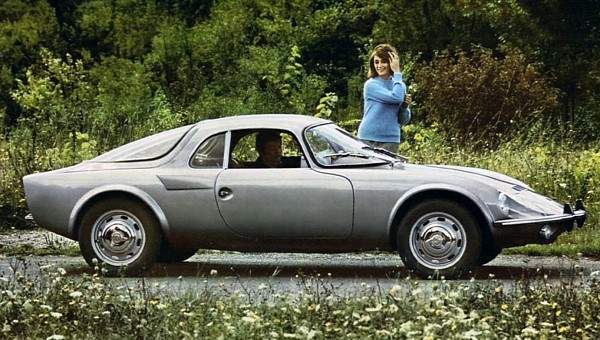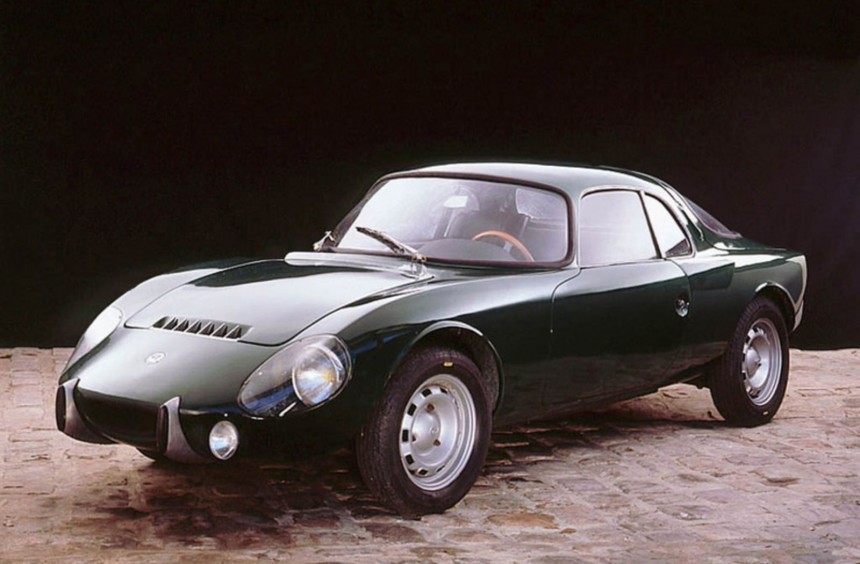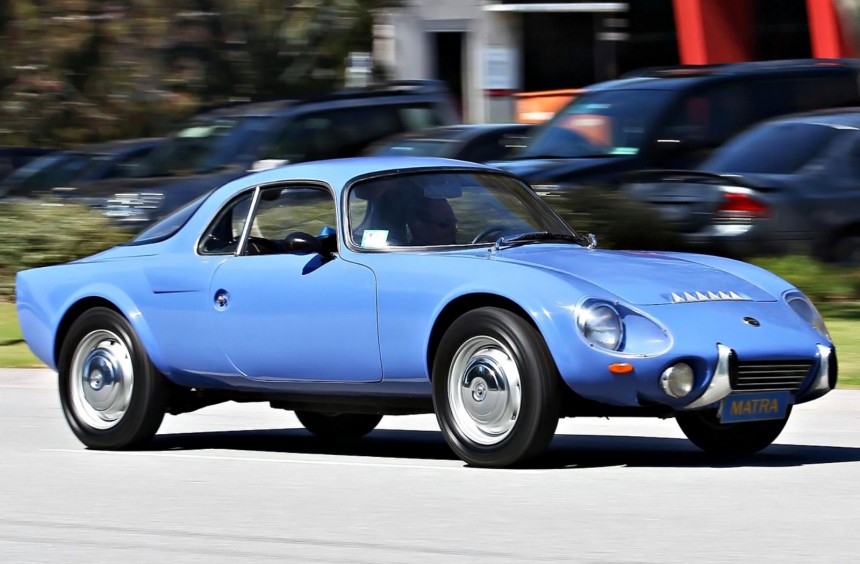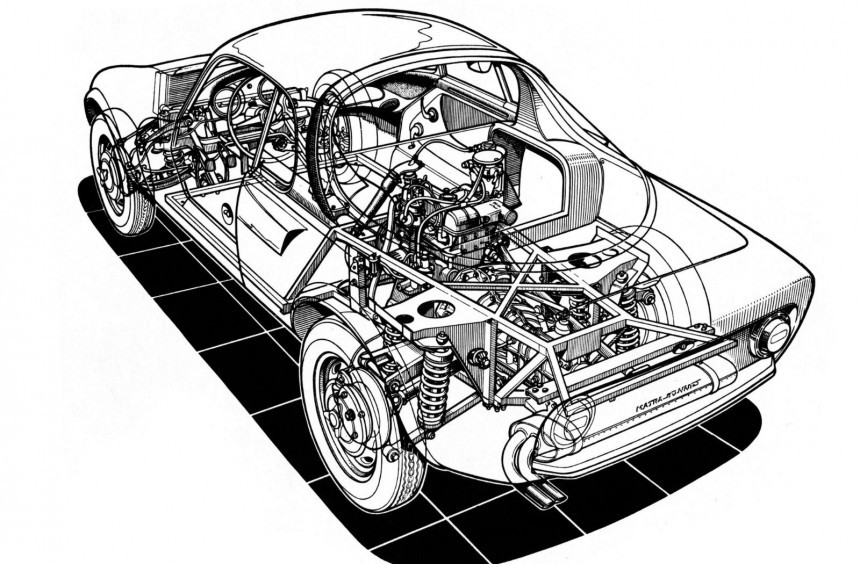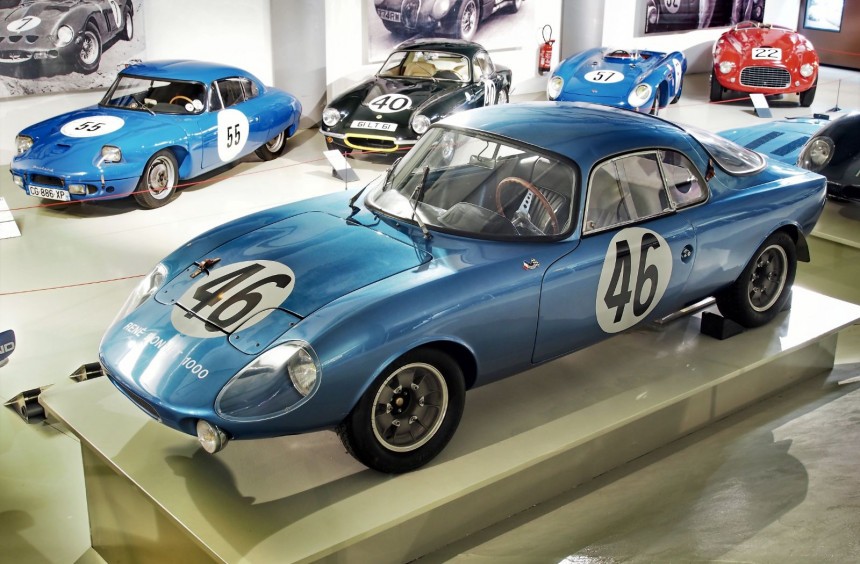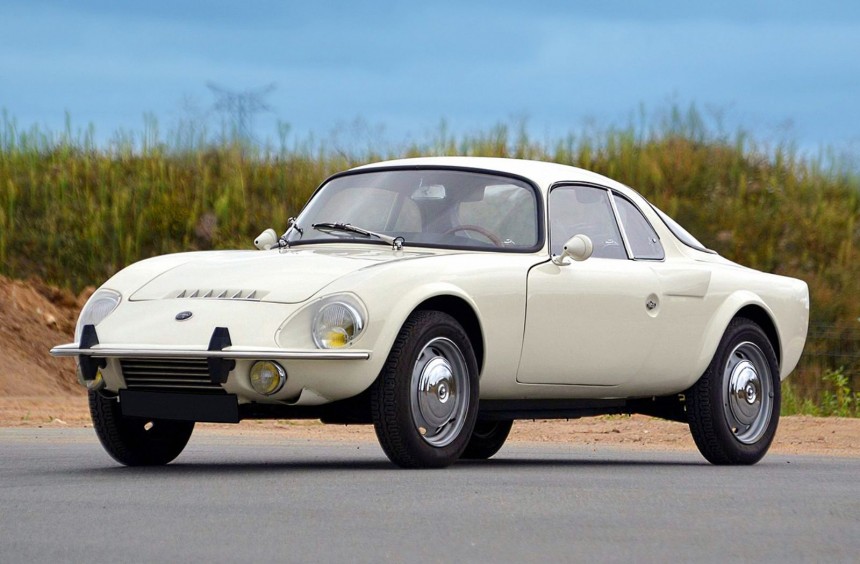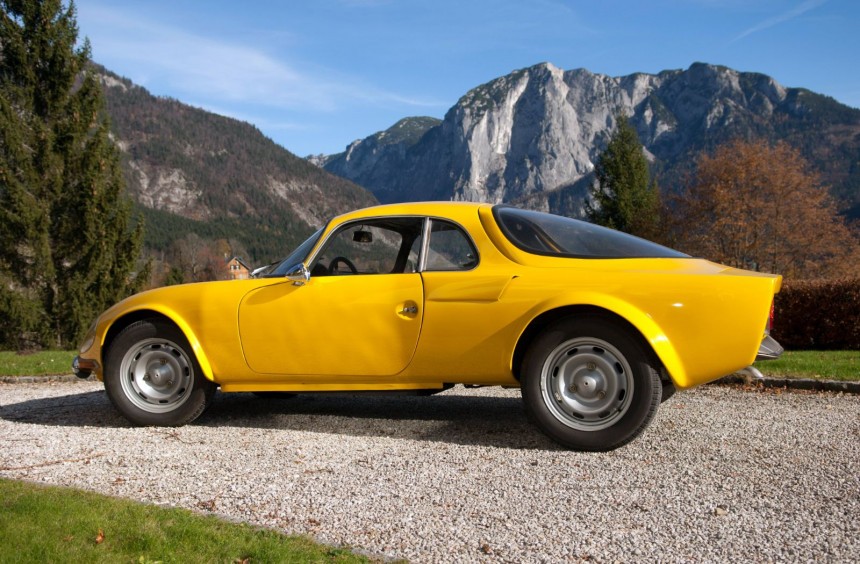Built in France during the 1960s, this little two-seater is all but forgotten today. While it was far from powerful, even for its era, the Djet deserves to be remembered for its simple, yet innovative design and for the fact that it was the world’s first series-production, mid-engine road car.
Placing the engine in the middle of the chassis, often towards the rear, behind the cockpit, was a revolutionary idea that drastically improved weight distribution and made sports cars far more exciting to drive.
Contrary to popular belief, this idea did not originate in the middle of the 20th century, but way back in 1900. Many automotive historians credit the NW Rennzweier race car as the first mid-engine design and by the 1950s, the idea was refined, giving birth to some iconic racers, most notably the Porsche 550.
While the 550 and other similar vehicles from the 1950s were often homologated for road use by their owners, these models were thoroughbred race cars, so none of them qualify for the distinction of the world’s first mid-engine road car. Instead, that honor goes to a tiny two-seater from France that is virtually unknown today.
Like all good automotive stories, it all started with a lifelong car enthusiast who ended up turning his dream into reality not by buying, but by building an awesome ride. His name was René Bonnet, and he was born in France in 1904, two days after Christmas. After a difficult childhood that forced him to drop out of school early and start working on a farm, he joined the French Navy, then played soccer for a local team, but after being diagnosed with tuberculosis, he ended up working for his recently-widowed sister, who inherited a small garage.
Bonnet was passionate about cars from an early age, so he enjoyed this new challenge. Apart from auto repairs, the garage was also a dealership for a French manufacturer called Rosengart, but by the time he joined, the company hadn’t managed to sell a single car. The new employee proved to be a valuable asset as his passion for cars, charisma, and negotiation skills helped the business flourish.
For the first time in his life, the Frenchmen was now earning good money, which he decided to invest in his own business. In 1932, Bonnet bought a small coachbuilder called "La Maison Deutsch" from the founder's widow and developed a close friendship with her son, Charles Deutsch, who continued to work for the company. Five years later, the two enthusiasts founded Deutsch-Bonnet (DB) in Champigny sur Marne, close to Paris, and started building some of France’s most exciting race cars, as well as some exclusive, low-volume road cars.
The partnership ended in 1961, when Deutsch left the company, but Bonnet wanted to continue building cars, so he renamed the business Automobiles René Bonnet.
Although racing car development continued to be the company’s main focus, Bonnet realized that there was money to be made from selling road cars. The DB Le Mans, a 2+2 convertible, continued to be marketed under the new brand, albeit equipped with a Renault engine, and a new two-seater called Missile which was based on the aforementioned model was introduced, but sales were slow, so the company needed to develop something much more exciting.
The solution envisioned by Bonnet was a lightweight two-seater that would bring an unprecedented amount of race tech to the world of road cars, mainly the mid-engine configuration.
Stylized by Jacques Hubert with valuable input from Bonnet himself, the new car dubbed Djet was constructed around a steel backbone chassis that was similar to what the era’s race cars were using. It was quite advanced for its time, employing a fully-independent suspension system with double A-arms, coil springs, as well as disc brakes on all four corners.
However, its most exciting feature was the mid-ship placement of its engine. As I mentioned before, by this time, many race cars used this configuration, but the Djet was the first pure road car to join the mid-engine club.
The unit itself was quite modest, even for the early 1960s. A small 1.1-liter, four-cylinder sourced from Renault, it was initially available in two output configurations, making either 71 or 79 hp. Linked with a four-speed manual taken from a Renault van, it sent only 62 lb-ft (84 Nm) of torque to the rear wheels in both output versions.
Still, the first iteration of the Djet introduced in 1962 could reach close to 110 mph (177 kph) thanks to a dry weight of only 1,344.8 lb (610 kg). This was made possible by the car’s fiberglass body panels, which were not only lightweight, but also aerodynamically efficient, resulting in a drag coefficient of 0.27, which is still impressive by modern standards.
Apart from the road cars, Bonnet also developed several competition-spec versions of the Djet. These cars were also powered by the Gordini engine, but it was beefed up with dual overhead cams which helped them produce up to 100 hp. One of these cars won the Experimental 1000 class at the 1962 24 Hours of Le Mans race.
The Djet was also used as the base for another successful René Bonnet racer called Aerodjet. Built around a lighter, more rigid tubular spaceframe chassis and donning upgraded body panels that made it more aerodynamically efficient, the Aerodjet won the Prototype 1150 class at Le Mans in 1963.
Even if it added two Le Mans class wins to its resume, the Djet, in its original street-legal guise, was nowhere near as successful as Bonnet had hoped. By mid-1964, the company only managed to sell around 180 road versions and its coffers were all but empty.
Facing bankruptcy, the founder was forced to sell his beloved brand to French industrial conglomerate Matra (Mécanique Aviation Traction), who was already supplying the body panels for the Djet and also owned the plant where the cars were being assembled.
Matra hired former Simca designer Philippe Guédon, who was tasked to redesign the Djet, which received a facelift and became slightly longer and wider. Production was halted from December 1964 to April 1965 to allow Guédon and his team to revamp the car.
After the Paris Motor Show motors held in the fall of 1965, the Roman numerals and the Bonnet name were dropped. The car was subsequently sold as Djet 5 and Djet 5 Sport.
A year later, the Djet 5 S was replaced by an improved version called Jet 6. While it was the heaviest iteration of the two-seater, weighing 1,631.4 lb (740 kg), it was also the fastest and most powerful. Renault provided the latest version of its Gordini for this model. The unit, which was shared with the likes of the Alpine A110 and R8 Gordini 1300, now displaced 1.3 liters and was rated at 102 hp. With this new powerplant, the Jet 6 could reach a top speed of 124.3 mph (200 mph), which, combined with its sharp handling, made it very popular among French enthusiasts.
The world’s first mid-engine road car was built until the end of 1967, but several Jet 6 examples were sold throughout 1968. As a Matra model, the car did much better on the market, with 1,495 units being sold.
Today, surviving Djet and Jet 6 examples can be had for anywhere from $20,000 to $60,000, depending on the production year and condition. Although forgotten by many, they're increasingly popular among classic car collectors who prefer something different.
You can learn more about this fantastic little car and see it being driven in the YouTube video below by DW News.
Contrary to popular belief, this idea did not originate in the middle of the 20th century, but way back in 1900. Many automotive historians credit the NW Rennzweier race car as the first mid-engine design and by the 1950s, the idea was refined, giving birth to some iconic racers, most notably the Porsche 550.
While the 550 and other similar vehicles from the 1950s were often homologated for road use by their owners, these models were thoroughbred race cars, so none of them qualify for the distinction of the world’s first mid-engine road car. Instead, that honor goes to a tiny two-seater from France that is virtually unknown today.
Humble beginnings
Bonnet was passionate about cars from an early age, so he enjoyed this new challenge. Apart from auto repairs, the garage was also a dealership for a French manufacturer called Rosengart, but by the time he joined, the company hadn’t managed to sell a single car. The new employee proved to be a valuable asset as his passion for cars, charisma, and negotiation skills helped the business flourish.
For the first time in his life, the Frenchmen was now earning good money, which he decided to invest in his own business. In 1932, Bonnet bought a small coachbuilder called "La Maison Deutsch" from the founder's widow and developed a close friendship with her son, Charles Deutsch, who continued to work for the company. Five years later, the two enthusiasts founded Deutsch-Bonnet (DB) in Champigny sur Marne, close to Paris, and started building some of France’s most exciting race cars, as well as some exclusive, low-volume road cars.
The world’s first mid-engine road car
Although racing car development continued to be the company’s main focus, Bonnet realized that there was money to be made from selling road cars. The DB Le Mans, a 2+2 convertible, continued to be marketed under the new brand, albeit equipped with a Renault engine, and a new two-seater called Missile which was based on the aforementioned model was introduced, but sales were slow, so the company needed to develop something much more exciting.
The solution envisioned by Bonnet was a lightweight two-seater that would bring an unprecedented amount of race tech to the world of road cars, mainly the mid-engine configuration.
A simple yet innovative design
However, its most exciting feature was the mid-ship placement of its engine. As I mentioned before, by this time, many race cars used this configuration, but the Djet was the first pure road car to join the mid-engine club.
The unit itself was quite modest, even for the early 1960s. A small 1.1-liter, four-cylinder sourced from Renault, it was initially available in two output configurations, making either 71 or 79 hp. Linked with a four-speed manual taken from a Renault van, it sent only 62 lb-ft (84 Nm) of torque to the rear wheels in both output versions.
Still, the first iteration of the Djet introduced in 1962 could reach close to 110 mph (177 kph) thanks to a dry weight of only 1,344.8 lb (610 kg). This was made possible by the car’s fiberglass body panels, which were not only lightweight, but also aerodynamically efficient, resulting in a drag coefficient of 0.27, which is still impressive by modern standards.
More power and a Le Mans Class-winning race version
In 1963, the Djet received a slightly better version of the Renault powerplant. Initially tuned by Gordini for the Renault 8 Gordini, it came with a cross-flow cylinder head and twin dual-choke Solex carburetors. The new hardware only bumped up the output to 85 hp and made the car 3.1 mph (5 kph) faster, but more importantly, it made it sound like a true sports car.
Apart from the road cars, Bonnet also developed several competition-spec versions of the Djet. These cars were also powered by the Gordini engine, but it was beefed up with dual overhead cams which helped them produce up to 100 hp. One of these cars won the Experimental 1000 class at the 1962 24 Hours of Le Mans race.
The Djet was also used as the base for another successful René Bonnet racer called Aerodjet. Built around a lighter, more rigid tubular spaceframe chassis and donning upgraded body panels that made it more aerodynamically efficient, the Aerodjet won the Prototype 1150 class at Le Mans in 1963.
Becoming a Matra model
Facing bankruptcy, the founder was forced to sell his beloved brand to French industrial conglomerate Matra (Mécanique Aviation Traction), who was already supplying the body panels for the Djet and also owned the plant where the cars were being assembled.
Matra hired former Simca designer Philippe Guédon, who was tasked to redesign the Djet, which received a facelift and became slightly longer and wider. Production was halted from December 1964 to April 1965 to allow Guédon and his team to revamp the car.
Two more years of development and greater sales success
For the 1965 model year, the Djet was available in two configurations. The entry-level model marketed as Matra-Bonnet Djet came with a 1.2-liter Renault Major engine capable of 69 hp, while the sportier, more expensive Djet V Sport (often abbreviated Djet V S) came with a Renault 8 Gordini unit that made 94 hp.
After the Paris Motor Show motors held in the fall of 1965, the Roman numerals and the Bonnet name were dropped. The car was subsequently sold as Djet 5 and Djet 5 Sport.
A year later, the Djet 5 S was replaced by an improved version called Jet 6. While it was the heaviest iteration of the two-seater, weighing 1,631.4 lb (740 kg), it was also the fastest and most powerful. Renault provided the latest version of its Gordini for this model. The unit, which was shared with the likes of the Alpine A110 and R8 Gordini 1300, now displaced 1.3 liters and was rated at 102 hp. With this new powerplant, the Jet 6 could reach a top speed of 124.3 mph (200 mph), which, combined with its sharp handling, made it very popular among French enthusiasts.
The world’s first mid-engine road car was built until the end of 1967, but several Jet 6 examples were sold throughout 1968. As a Matra model, the car did much better on the market, with 1,495 units being sold.
Today, surviving Djet and Jet 6 examples can be had for anywhere from $20,000 to $60,000, depending on the production year and condition. Although forgotten by many, they're increasingly popular among classic car collectors who prefer something different.
You can learn more about this fantastic little car and see it being driven in the YouTube video below by DW News.
